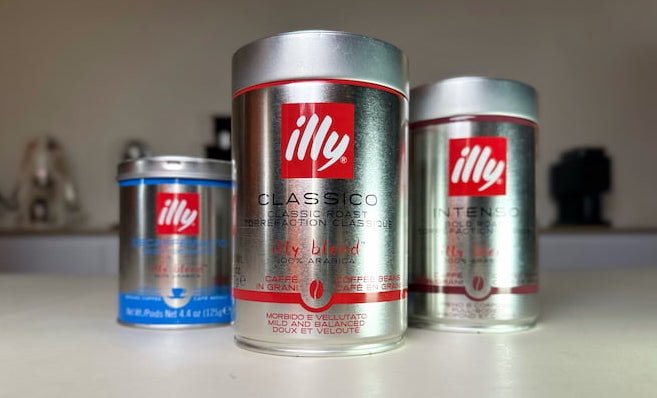Illycaffè, or simply Illy, is a coffee brand that will divide the readers of this blog.
To some, it’s a symbol of luxury, while others, more familiar with modern coffee, might disagree and see it as the antithesis of specialty coffee.
So, where does the truth lie? That’s what I aim to explore in this article.
I tested three of the most popular Illy blends (click to jump directly)
I approached the evaluation by setting aside any biases I might hold as a self-proclaimed third-wave coffee snob, ehm, enthusiast…
At the same time, I incorporated the objective standards I adhere to as a licensed Q Grader.
Before diving into this review, let me say that the aluminum canisters of Illy coffee held both delightful surprises and unexpected disappointments 🙅
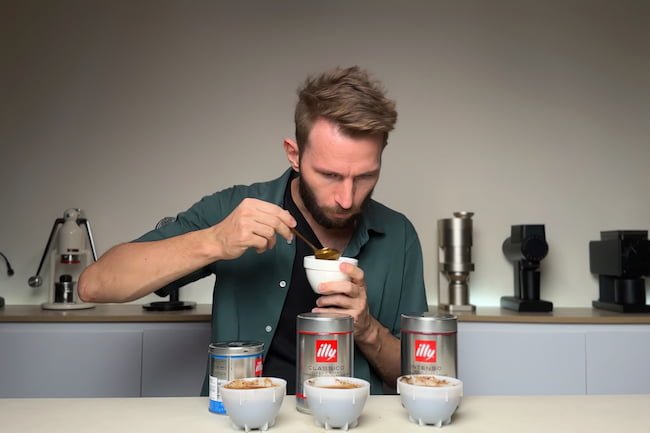
Illycaffè: An Italian brand created by a hungarian
Contrary to popular belief, Illy was NOT founded by an Italian.
Ferenc Illy, born in Timișoara, then part of the Kingdom of Hungary (now, Romania) established the brand.
After fighting in World War I in the Austro-Hungarian army, he relocated to Italy, settling in Trieste. Adapting to his new home, Ferenc took the Italianized name “Francesco.” In Trieste, he began a venture in chocolate and coffee, which eventually blossomed into Illycaffè in 1933.
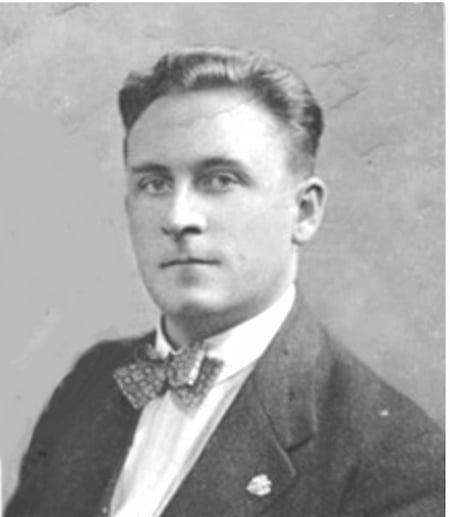
In 1934, Illy got the idea to pack his beans under pressure, which is still how the company stores coffee today. Perhaps the sturdy-looking canister is one of the explanations for Illy’s worldwide success.
Illy has made a significant impact on the coffee industry. While this is particularly true when we look back at earlier history, their recent contributions to specialty coffee are also noteworthy.
The current generation of coffee aficionados might be surprised to learn that Illy’s espresso blend was used by the winners of the World Barista Championships in 2001 and 2002. Such a choice seems unthinkable today, as exotic varieties and complex processes dominate the competition scene.
Illy’s journey towards excellence was significantly influenced by Francesco Illy’s son, Ernesto Illy. Ernesto, a chemist and food scientist, joined the company early in his career and steered it towards a science-driven approach, establishing a research lab in 1957.

Now, the company is led by his son, Andrea Illy. Together, the two younger Illys have written a pivotal book on espresso and founded a coffee university, further cementing their influence in the industry.
The company’s decision to exclusively use Arabica beans, forsaking the cheaper Robusta, is another notable decision. In the Italian market, where Robusta is commonly used, this move underscored their commitment to quality over cost.
(Sidenote💡: Personally, I don’t think Robusta is the villain that many people have made it out to be)
About the Review Methodology
For this review, I began by cupping all three blends. Although cupping is traditionally more suited for light to medium roast beans, I believe it reveals much about any coffee type. Following the cupping, I prepared espresso and milk-based drinks to assess the blends comprehensively.
Illy Intenso review

Cupping: Opening the sealed aluminum can of Illy Intenso, my first impression was clear: this is a dark roast. Yet, there are definitely roasts out there that are darker. The beans aren’t overtly oily, typical for ultra-dark roasts like French or Italian. However, signs of the second crack are evident in many beans, indicated by small holes. The first crack is a gentle pop, but the second crack is more intense, often ejecting small shrapnels of the bean and leaving a tiny hole.
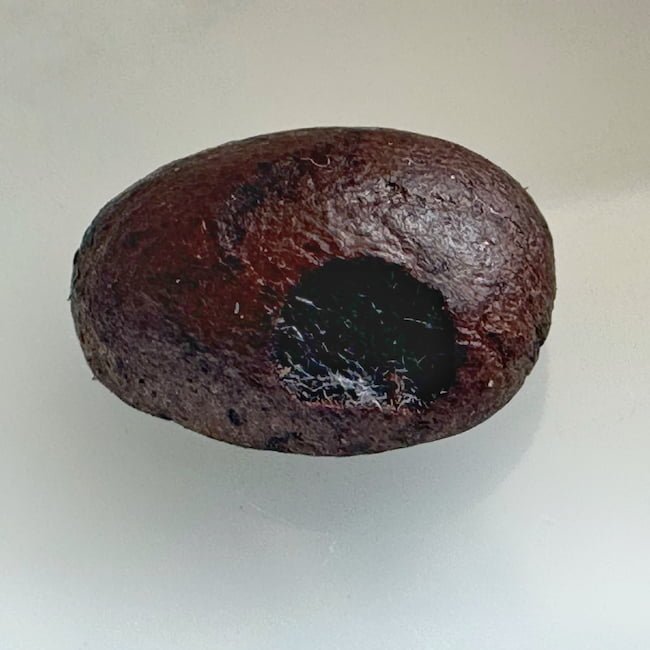
Interestingly, the Intenso blend also had more broken beans compared to the Classico blend.
I wondered about the cause of these broken beans. Given that the coffee is stored in a sturdy aluminum container, could they have been broken before roasting? Specialty coffee adheres to strict standards, including limiting defects such as broken beans. The industry standard is no primary defects in a 350-gram sample. Broken beans are, however, only a secondary defect, and a maximum of five pieces are allowed in each sample.
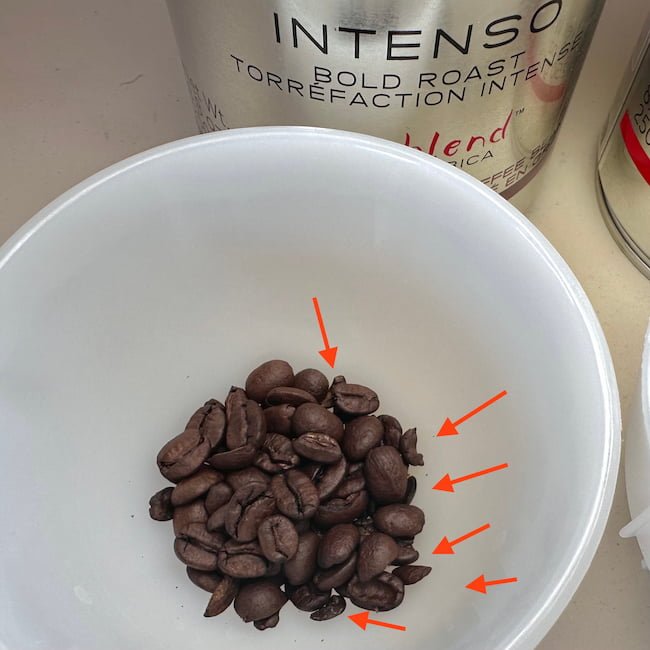
A quick assessment suggested that the Intenso blend exceeded this limit, potentially disqualifying it as specialty coffee. Broken beans can cause uneven roasting, leading to off-flavors. Uniform beans ensure a more consistent roast. This is why coffee is sorted and graded into categories like AA, B, and Peaberry.

In the cupping bowl, the coffee lacked the traits I associate with high-end coffee. Of course, the dark roast made it difficult to discern the coffee’s origin character. Any unique traits of the blend were overshadowed by the roast characteristics. The Intenso lived up to its name with a robust, dark roast flavor. But was it intense in a good way? I’m not so sure. The flavor profile is dominated by notes of an almost ashtray-like main note, followed by spices like anise and licorice, with just a hint of molasses.
Espresso: As an espresso, Intenso was relatively easy to dial in, producing a slightly nicer crema than the Classico blend. The shot resembled what many might consider a classic Italian espresso, but it lacked the subtle notes found in the Classico.
As expected, the blend performed quite well in milk-based drinks like cappuccinos, made with both regular and oat milk. Dark roasts, despite their bad reputation in modern coffee circles, are often great for milky beverages. Their roasty bittersweet flavor harmonizes well with the creaminess of milk.
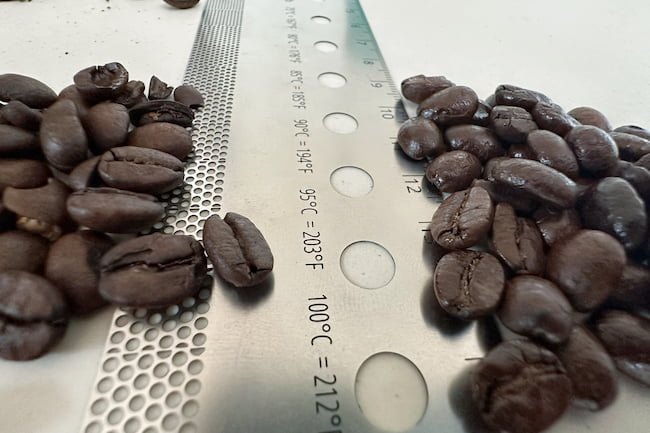
Overall, the Intenso caters to those seeking a coffee with strong character and a roasty taste. Does it justify its price? I’m skeptical. While the Classico beans seem to be specialty grade, the Intenso blend’s value is harder to justify. This type of dark roast is readily available elsewhere, and you can probably get it with a fresher roast date. Secondly, the presence of broken beans suggests that Intenso might be composed of lower-tier beans, not suitable for Illy’s other offerings.
Where to buy?
➡️ 1st in Coffee
➡️ Amazon
Illy Classico Review
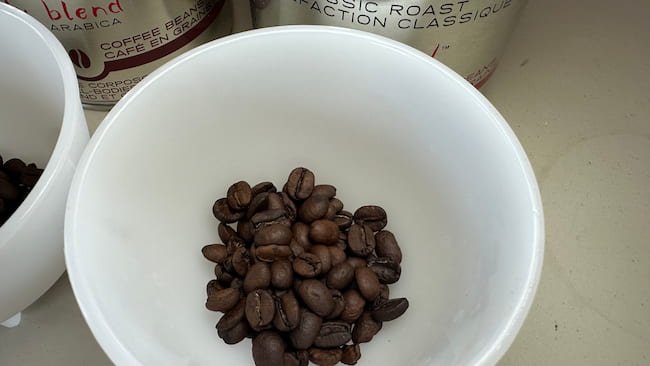
Cupping: In the cupping bowl, Illy’s Classico blend made a solid impression, particularly when compared to its close relative, the Intenso.
Illy Classico is not a dark roast; rather, it falls into the category of a “developed” medium roast. This coffee provides a hint of origin character. I believe the beans in this blend would score enough to be considered specialty-grade coffee, meaning above 80 points. However, a lighter and fresher roast would be needed to confidently grade it.
In the cupping bowl, a subtle hint of fruit caught my attention. It wasn’t the fresh fruit commonly found in many specialty coffees, but more akin to dried fruit, resembling a raisin or prune. The cup also had a decent level of sweetness, complemented by nutty and chocolatey notes.
Espresso:
The espresso displayed a slightly thin and pale crema, not unusual given that Illy roasts are rarely fresh. You’d have to be quite lucky to find a batch roasted within the 5-week window I’d consider fresh for espresso. However, Illy’s special packaging technology raised my hopes that this effect would be somewhat mitigated.
Illy Classico is noteworthy in that it contains no Robusta and leans towards a medium roast. Both factors contribute to less crema.
The first sip of the shot was very comforting and rather predictable. The chocolate from the cupping session now appeared as a blend of cacao and almond notes.
This blend is more elegant and restrained compared to many other Italian espresso blends – or at least compared to the global perception of Italian espresso. It reminded me slightly of Lavazza’s Espresso Italiano, which I tested a few years ago; that too is more of a medium roast, diverging from what many expect of Italian coffee.
As the coffee cooled, it began to reveal a more classic character that I associate with Indian coffee. If I had to guess, this origin forms a significant part of Illy’s Classico blend, with the sweet raisin notes likely coming from naturally processed Brazilian beans. Illy claims the blend consists of beans from 9 different origins, but this seems more aimed at ensuring consistency rather than unique flavors. I believe a similar taste profile could be achieved with just 2-3 different beans.
During my testing period with Illy Classico, I noticed the blend resembled my approach to roasting espresso coffee, where the goal is to extend the development phase post-first crack while avoiding high temperatures that lead to a second crack. Done correctly, this method yields nutty espressos with low bitterness but enough origin character to remain interesting, either as an espresso or straight Americano.
The company claims that there are notes of jasmin and orange blossom in the blend, but I find that to be a bit too poetic. With some imagination, I’d go as far as to say that you can detect a tiny hint of orange peel in the aftertaste, provided that you use a high quality grinder, and are able to pull a perfectly extracted shot.
Illy Classico performed adequately in the few cappuccinos I made. They were sweet and comforting, adding a pleasant Nutella-like touch. However, due to its lack of the burnt flavors found in darker roasts, Classico can be easily overwhelmed in milk-heavy drinks. I wouldn’t recommend it for a latte, but it works well in a cortado or small cappuccino.
Overall, Classico met my expectations as an elegant and refined espresso, albeit a bit on the conservative side.
If I wanted something classical and comforting like this I’d probably go for something like the Espresso Roast from my good friends from Coffee Bros. Buying from a smaller, local roaster you can be sure to get freshly roasted coffee and you also get an idea what components the blend is made up of.
Where to buy?
➡️ 1st in Coffee
Illy Decaf
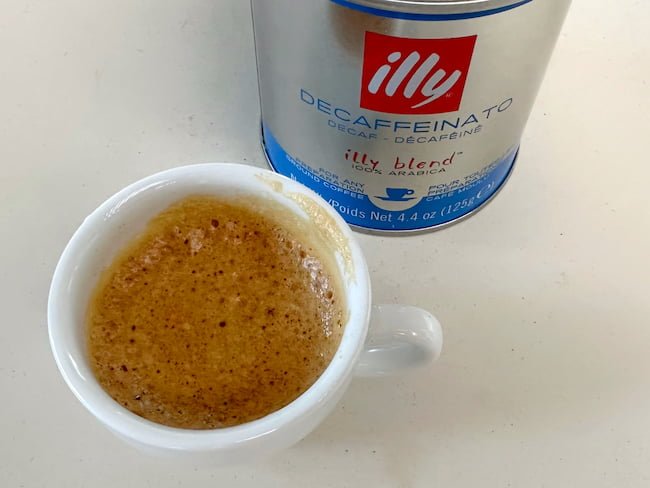
Cupping:
Illy’s decaf was an outlier in my taste test, primarily because it was preground rather than whole bean. This distinction made it somewhat challenging to evaluate compared to the other whole bean samples. However, this provided an opportunity to better understand Illy’s grinding level, valuable information for those considering a pre-ground Illy blend.
In terms of roast level, the decaf coffee color suggests it falls between the Classico and Intenso.
When I approached Illy’s Decaf blend, I was skeptical about decaffeinated coffees. Surprisingly, this blend delivered a pleasant experience. It presented a prominent cocoa note and an unexpected hint of Earl Grey tea, possibly of Ethiopian origin, known for its tea-like flavor. This added a compelling layer to the coffee’s profile.
Espresso:
The preground coffee faced challenges in generating sufficient pressure in a standard espresso machine, hinting at the need for alternative brewing methods. Yet, the flavor profile was unexpectedly smooth and well-rounded. As it cooled, the blend retained the Classico’s quality characteristics, with an added complexity. For a decaf, it was not bad.
The grind was relatively fine, but not suitable for authentic 9-bar espresso extraction. Attempting to pull a shot with this coffee resulted in quick water flow, producing a thin and underwhelming cup.
However, using a pressurized portafilter yielded something closer to an espresso shot. My machine brewed the coffee fairly quickly, resulting in that characteristic, frothy crema associated with pressurized espresso baskets.
I believe the blend and preground coffee in general, aren’t well-suited for espresso brewing. Instead, I recommend this coffee for longer brews at a 1:6-1:12 ratio, making brewing methods like the AeroPress and Moka Pot ideal for Illy’s pre-ground coffee. Given that this is a decaf blend, a longer coffee also seems more appropriate. Decaf is typically enjoyed as a comforting beverage to sip on in the evening, rather than a quick espresso shot.
Interestingly, the decaf blend had the most intriguing notes among the three Illy blends I sampled. I’d likely purchase it if available in whole bean form, as finding a good decaf is rare.
Where to buy?
➡️ 1st in Coffee

Conclusion
Exploring these three Illy blends – Classico, Intenso, and Decaf – was a revealing experience. Each blend showcased its distinct character: the balanced and classic Classico, the roasty and toasty Intenso, and the unexpectedly enjoyable Decaf.
While there are many specialty coffees that offer fresher and more intriguing flavors than Illy’s options, the consistency and elegance of the Classico blend provide a comforting fallback.
Personally, I don’t find the Intenso worth the investment, considering the availability of similar, more affordable options from local supermarket brands or international roasters like Starbucks, who also favor darker roasts. While I understand the appeal of dark roasts, I recommend exploring fresher and more reasonably priced alternatives.
Revisiting these beans was a valuable exercise in challenging my preconceptions. Illy may seem pricey, but its flagship Classico blend has been a cornerstone in modern coffee culture. And it likely will remain a staple for years to come.
As I mentioned in my article about Lavazza a few years back, the main challenge with these Italian brands is that you never find them with a super-fresh roast date in the supermarket. Again, I feel this is the case here. Even though Illy uses its unique technology to pressure-seal the beans, I’m sure they could taste just a tiny bit better. Maybe I’ll just have to visit Trieste, Italy soon?
If you have read all this way, then thanks for the support! If you have experience with Illy and want to share it with me and fellow coffee lovers, then feel free to drop a comment on this video on YouTube!
